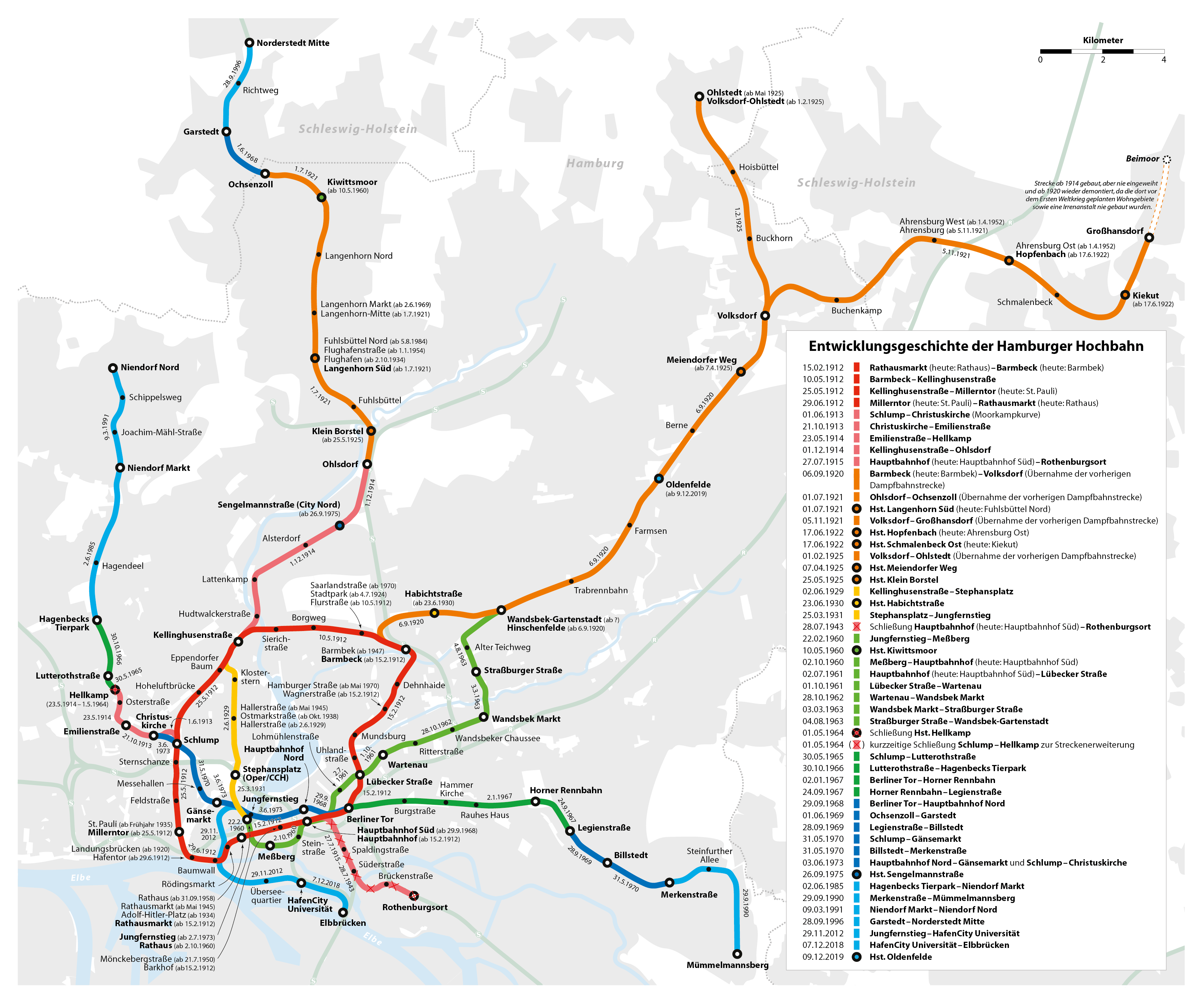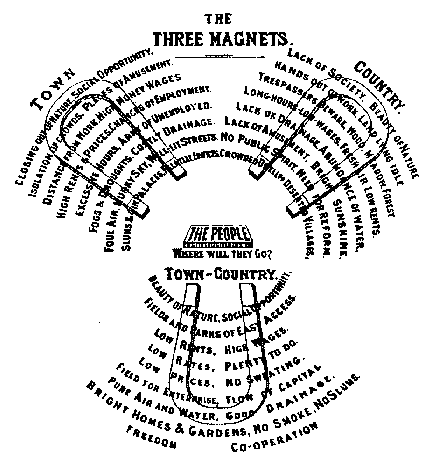|
Wandsbek-Gartenstadt (Hamburg U-Bahn Station)
Wandsbek-Gartenstadt is a major rapid transit station on the Hamburg U-Bahn lines U1 and U3. For line U1, Wandsbek-Gartenstadt is a through station; for line U3, it is terminus station. The station is located in the Gartenstadt (garden city) of Wandsbek, Germany. Wandsbek is center of the Hamburg borough of Wandsbek. History The station was opened in 1918 by the name "Hinschenfelde" and as part of Hamburg's Walddörferbahn. In 1920 the station was electrified, renamed "Wandsbek-Gartenstadt" and integrated into the Hamburger Hochbahn network. On 4 August 1963 the second rail line was opened. Since 2014, ongoing modernization works on the station building and the station platforms are underway, including raised platforms for handicap-accessibility and new platform roofs. Since May 2014, the northbound trains are accessible via an elevator, the southbound trains are expected to be equipped accordingly by the end of 2014. Layout The station is located on the northern side of O ... [...More Info...] [...Related Items...] OR: [Wikipedia] [Google] [Baidu] |
List Of Hamburg U-Bahn Stations
The following list contains all 93 stations of the Hamburg U-Bahn. The Hamburg U-Bahn is operated by the Hamburger Hochbahn (HHA) under the supervision of the Hamburger Verkehrsverbund. The majority of stations are located within the borders of the city of Hamburg — only nine stations are in the German state of Schleswig-Holstein outside the city limits — and all stations are located on the right bank of the Elbe river. Stations This list gives the name of each station, the lines serving the station, the quarter and the fare zones, in which it is located, and the date or dates opened. All stations are located in the fare zone ''Greater Hamburg Area''. Included are all stations currently open on the Hamburg U-Bahn. See also * List of railway stations in Hamburg * List of Hamburg S-Bahn stations Notes :A. The Hamburger Verkehrsverbund uses a system of concentric zones for the calculation of fares between stations. Fares between any station in one zone ... [...More Info...] [...Related Items...] OR: [Wikipedia] [Google] [Baidu] |
Germany
Germany,, officially the Federal Republic of Germany, is a country in Central Europe. It is the second most populous country in Europe after Russia, and the most populous member state of the European Union. Germany is situated between the Baltic and North seas to the north, and the Alps to the south; it covers an area of , with a population of almost 84 million within its 16 constituent states. Germany borders Denmark to the north, Poland and the Czech Republic to the east, Austria and Switzerland to the south, and France, Luxembourg, Belgium, and the Netherlands to the west. The nation's capital and most populous city is Berlin and its financial centre is Frankfurt; the largest urban area is the Ruhr. Various Germanic tribes have inhabited the northern parts of modern Germany since classical antiquity. A region named Germania was documented before AD 100. In 962, the Kingdom of Germany formed the bulk of the Holy Roman Empire. During the 16th ce ... [...More Info...] [...Related Items...] OR: [Wikipedia] [Google] [Baidu] |
U3 (Hamburg U-Bahn) Stations
U3 or U-3 may refer to: Transportation * U3, an underground rapid transit line in many major German/Austrian cities: ** U3 (Berlin U-Bahn) ** U3 (Frankfurt U-Bahn) ** U3 (Hamburg U-Bahn) ** U3 (Munich U-Bahn) ** U3 (Nuremberg U-Bahn) ** U3 (Stuttgart Stadtbahn) ** U3 (Vienna U-Bahn) * Avies (IATA code: U3), an Estonian airline * Cessna U-3, the military model of the Cessna 310 aircraft * German submarine ''U-3'', one of several German submarines * Boeing Customer Code for Garuda Indonesia Computer technology * U3 (software), a design specification for USB storage, created by U3, LLC * U3, a speed class for Secure Digital (SD) cards * U.3, an improvement to the U.2 storage interface standard Video games * '' Ultima III: Exodus'', a 1983 video game * '' Uncharted 3: Drake's Deception'', a 2011 video game Other * U3, an unemployment figure released by the United States Bureau of Labor Statistics * Small nucleolar RNA U3 In molecular biology, U3 snoRNA is a non-coding RNA found ... [...More Info...] [...Related Items...] OR: [Wikipedia] [Google] [Baidu] |
U1 (Hamburg U-Bahn) Stations
U1, U.I or U-1 may refer to: Mathematics *U(1), the degree one ''unitary group'' Military *U-1, the USAF and US Military's designation for the De Havilland Canada DHC-3 Otter light transport aircraft *U-1, Soviet designation for Avro 504 trainer. *Multiple German U-boats named ''U-1'' *Oberursel U.I, an early German aircraft engine *HDMS U-1, a Danish submarine * SM U-1, an Austro-Hungarian submarine, lead ship of the U-1 class Entertainment *U1 Technology, a game and software developing company *'' Ultima I: The First Age of Darkness'', a 1981 video game People * U1, alias for Yuvan Shankar Raja (born 1979), a Tamil musician and film composer *U-1, the main character in the video game ''Gitaroo Man'' for the PlayStation 2/PlayStation Portable Railways *LNER Class U1, a 1924 British solitary 2-8-0+0-8-2 Beyer-Garratt locomotive *SR U1 class, a class of 2-6-0 locomotives developed from the U Class U-Bahn lines *U1 (Berlin U-Bahn) *U1 (Frankfurt U-Bahn) *U1 (Hamburg U-Bahn) * ... [...More Info...] [...Related Items...] OR: [Wikipedia] [Google] [Baidu] |
Buildings And Structures In Wandsbek
A building, or edifice, is an enclosed structure with a roof and walls standing more or less permanently in one place, such as a house or factory (although there's also portable buildings). Buildings come in a variety of sizes, shapes, and functions, and have been adapted throughout history for a wide number of factors, from building materials available, to weather conditions, land prices, ground conditions, specific uses, prestige, and aesthetic reasons. To better understand the term ''building'' compare the list of nonbuilding structures. Buildings serve several societal needs – primarily as shelter from weather, security, living space, privacy, to store belongings, and to comfortably live and work. A building as a shelter represents a physical division of the human habitat (a place of comfort and safety) and the ''outside'' (a place that at times may be harsh and harmful). Ever since the first cave paintings, buildings have also become objects or canvasses of much artis ... [...More Info...] [...Related Items...] OR: [Wikipedia] [Google] [Baidu] |
Hamburg U-Bahn Stations In Hamburg
(male), (female) en, Hamburger(s), Hamburgian(s) , timezone1 = Central (CET) , utc_offset1 = +1 , timezone1_DST = Central (CEST) , utc_offset1_DST = +2 , postal_code_type = Postal code(s) , postal_code = 20001–21149, 22001–22769 , area_code_type = Area code(s) , area_code = 040 , registration_plate = , blank_name_sec1 = GRP (nominal) , blank_info_sec1 = €123 billion (2019) , blank1_name_sec1 = GRP per capita , blank1_info_sec1 = €67,000 (2019) , blank1_name_sec2 = HDI (2018) , blank1_info_sec2 = 0.976 · 1st of 16 , iso_code = DE-HH , blank_name_sec2 = NUTS Region , blank_info_sec2 = DE6 , website = , footnotes ... [...More Info...] [...Related Items...] OR: [Wikipedia] [Google] [Baidu] |
Cross-platform Interchange
A cross-platform interchange is a type of interchange between different lines at a metro (or other railway) station. The term originates with the London Underground; such layouts exist in other networks but are not commonly so named. In the United States, it is often referred to as a cross-platform transfer. This configuration occurs at a station with island platforms, with a single platform in between the tracks allocated to two directions of travel, or two side platforms between the tracks, connected by level corridors. The benefit of this design is that passengers do not need to use stairs to another platform level for transfer. A cross-platform interchange arrangement may be costly to build due to the complexity of rail alignment, especially if the railway designers also arrange the track with flyovers (which is typically done to increase efficiency). A typical bidirectional cross-platform interchange configuration consists of two outbound directions of two different lines ... [...More Info...] [...Related Items...] OR: [Wikipedia] [Google] [Baidu] |
Wandsbek
Wandsbek () is the second-largest of seven Boroughs and quarters of Hamburg#Boroughs, boroughs that make up the city and state of Hamburg, Germany. The name of the district is derived from the river Wandse which passes through here. Hamburg-Wandsbek, Wandsbek, which was formerly an independent city, is urban and, along with Hamburg-Eilbek, Eilbek and Marienthal, part of the city's economic and cultural core. In 2020 the population was 442,702. History Wandsbek was the place of residence of the poet Johann Heinrich Voss and of Matthias Claudius, who here issued (1771–1775) the newspaper (The Wandsbeck Messenger). There is a monument to Claudius in the town. During World War II from May 2, 1944 until May 3, 1945 a subcamp of the Nazi concentration camp of Neuengamme concentration camp, Neuengamme was located in Wandsbek, listed as no. 565 Hamburg-Wandsbek in the official German list. On January 1, 2007 the ''Ortsämter'' (Precincts) were dissolved and the organisation of all bor ... [...More Info...] [...Related Items...] OR: [Wikipedia] [Google] [Baidu] |
Wandsbek (quarter)
Wandsbek () is an urban quarter in the Wandsbek borough of Hamburg, Germany, and the former city Wandsbek in the Duchy of Holstein. In 2020 the population was 36,671. History Wandsbek was once part of the county ''Stormarn''. Its villages were first mentioned in the middle of the 13th century. The name ''Wandsbek'', ''Wandsbeck'' or (older) ''Wantesbeke'' derives from old Low Saxon ("Low German") for "border river" and the river Wandse was a natural territorial border. An old Danish phrase for stating that something is a fraud / unreliable is to claim that ''"det gælder ad Wandsbek Vandsbæktil"'' (i.e. ''"this is valid in Wandsbeck."''). Wandsbek was one of the three locations in the Danish monarchy where the first lottery drew its numbers, and this expression dates from the early years of this lottery's life where a number of people tried to claim prizes in Copenhagen with tickets from Wandsbeck. Since each of the three towns drew its own set of numbers, a ticket from one tow ... [...More Info...] [...Related Items...] OR: [Wikipedia] [Google] [Baidu] |
Hamburg
(male), (female) en, Hamburger(s), Hamburgian(s) , timezone1 = Central (CET) , utc_offset1 = +1 , timezone1_DST = Central (CEST) , utc_offset1_DST = +2 , postal_code_type = Postal code(s) , postal_code = 20001–21149, 22001–22769 , area_code_type = Area code(s) , area_code = 040 , registration_plate = , blank_name_sec1 = GRP (nominal) , blank_info_sec1 = €123 billion (2019) , blank1_name_sec1 = GRP per capita , blank1_info_sec1 = €67,000 (2019) , blank1_name_sec2 = HDI (2018) , blank1_info_sec2 = 0.976 · 1st of 16 , iso_code = DE-HH , blank_name_sec2 = NUTS Region , blank_info_sec2 = DE6 , website = , footnotes ... [...More Info...] [...Related Items...] OR: [Wikipedia] [Google] [Baidu] |
Garden City Movement
The garden city movement was a 20th century urban planning movement promoting satellite communities surrounding the central city and separated with greenbelts. These Garden Cities would contain proportionate areas of residences, industry, and agriculture. Ebenezer Howard first posited the idea in 1898 as a way to capture the primary benefits of the countryside and the city while avoiding the disadvantages presented by both. In the early 20th century, Letchworth, Brentham Garden Suburb and Welwyn Garden City were built in or near London according to Howard's concept and many other garden cities inspired by his model have since been built all over the world. History Conception Inspired by the utopian novel ''Looking Backward'' and Henry George's work ''Progress and Poverty'', Howard published the book '': a Peaceful Path to Real Reform'' in 1898 (which was reissued in 1902 as ''Garden Cities of To-morrow''). His idealised garden city would house 32,000 people on a site of , pl ... [...More Info...] [...Related Items...] OR: [Wikipedia] [Google] [Baidu] |





